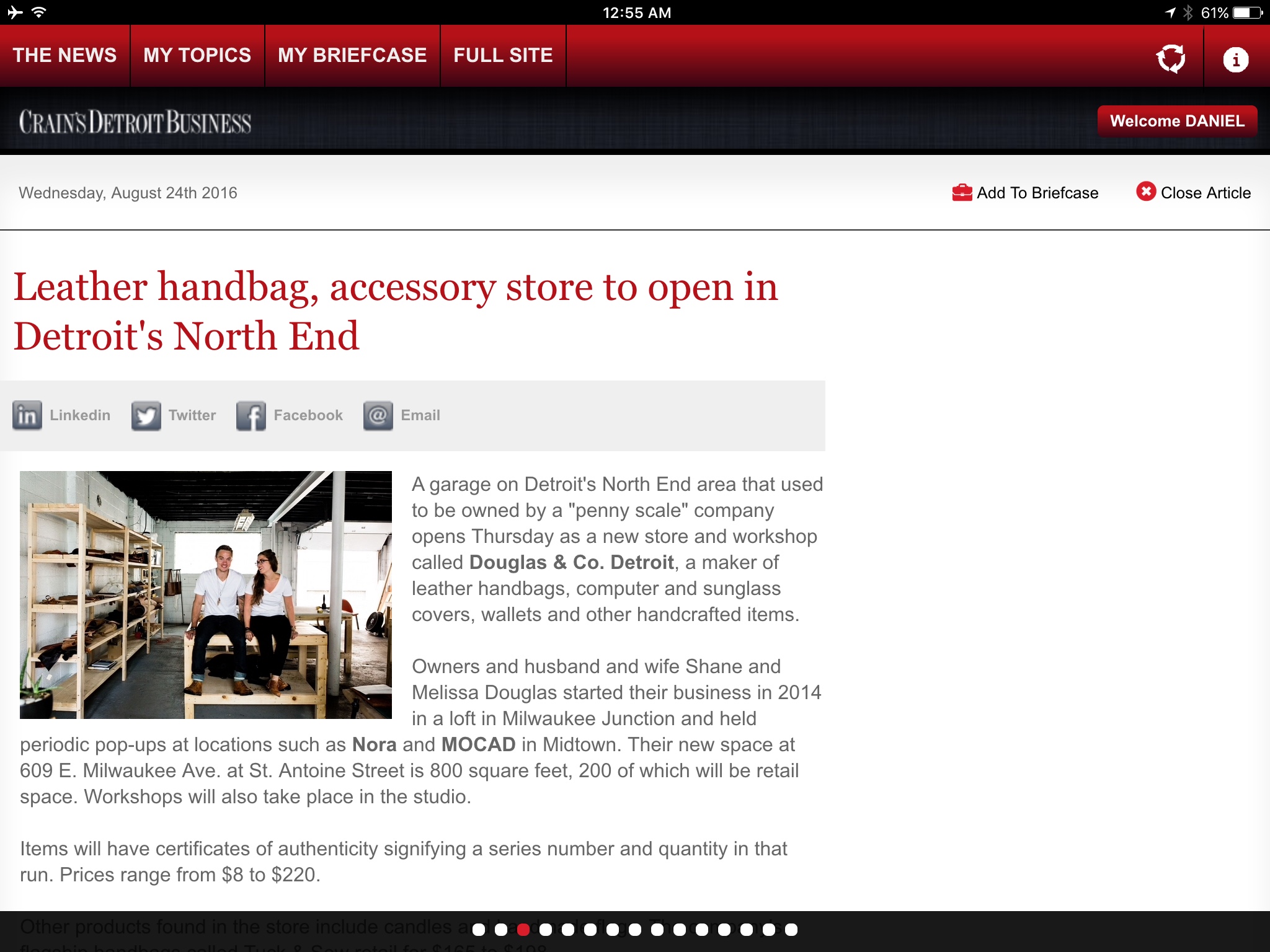5 things to include in your social media policy
Business Must Embrace Social Media
Facebook, Twitter and Instagram is no longer used to post what your college roommate from decades ago had for dinner. Social media is a vital tool to a companies sales funnel and managing its reputation. For many companies it is the first line of defense, an early warning system into issues becoming problems and problems turning into crises. To manage risk and monitor the digital chatter, companies should have a social media policy. Here are a few tips in drafting that policy.
Social media is no longer about what you had for dinner
Are you listening? Why monitoring social media chatter can make or break your reputation.
If you or your company is not on social media, you should. After all, just because you or your company is not Tweeting or otherwise posting pictures or updates, does not prevent others from talking about you. It is important for you to listen to the chatter, know the influencers or where the discussion got started in the first place.
When the Democrats Speak, Will The People Listen
Both business and labor still have a lot to learn in regards to how to harness the power of social and they should be watching this week’s debate, monitoring the candidates social media in addition to those of the issues groups with an interest in the campaign.
A Union Rediscovering Itself Through Social Media
Don't Do It, Just Because Everyone Else Is!
Be a follower at your next trade show
Social media is a blessing and a curse. There is so much to do and so many people to follow that we can waste so much time posting and following. However, in regards to getting the most out of trade shows and conventions, social media continues to change the we we collaborate, communicate and educate and it could add value to your next conference or trade show.
So whether your company has an exhibit or booth at the event or you are simply walking the trade show floor, depending on what you want to get out of event, here are a few tips for using social media:
Pre-Show
- Set Goals - Why are you attending this event? For example to learn or network, build a social media following or just experiment with social media
- Become a Follower/Twitter - Follow the major media outlets and show organizers to get the latest information on the event and to see what is trending and who is commenting.
- Start pre show teasers for your campaign
- Develop an on site and post show plan
- Work to become relevant to the conversation
- Retweet often to get noticed by the conference influencers
- Tweet using the official hashtag leading up to the event
- Follow other firms, industry organizations and others that will exhibit or speak at the event.
- Link-In before you leave - Use LinkedIn Updates to find out who's talking about the event.
- Update your status to reflect your plans at the event.
- Use Linked In to connect with potential venders, partners, clients and peers a the show.
- Schedule meetings through LinkedIn.
- Download the mobile app
DURING THE SHOW
- Stay connected to the action of the show using the official (and unofficial) hashtags
- Share your experience through your blog, Facebook and Twiter,
- Use Instagram to capture and share show photos
- Explore new social media such as Meerekat and Periscope, even Snapchat -- these events are great ways to explore and get comfortable with social media.
- Retweet posts from other influencers
After the Show
- Connect to those that you met via LinkedIn and Twitter
- Send thank you's to those that you connected with (I still like to write personal handwritten notes, in addition to email/LinkedIn messages)
- Stay connected and continue the conversation even when your return to your office.
In regards to media relations, you should also familiarize yourself with the trade media covering these events and work several months in advance to place your products and projects in their publications or work with them to place other content in the materials that will be distributed on the trade show floor. This may include sponsoring content and you should prepare a marketing budget to further assist you in reaching your goals while attending the event.
Sharing Bad News With Employees
5 lessons in PR from the ice bucket challenge
It all started with one challenge and one name and now Facebook is inundated with videos of people accepting the Ice Bucket Challenge. Luckily for ALS, so too are their on-line donations. From celebrities, singers and athletes such as Ben Affleck, Taylor Swift and LeBron James, to politicians, such as New Jersey Governor Chris Christie or Michigan Governor Rick Snyder, and business icons such as Bill Gates, we are all accepting and having fun with the ice bucket challenge and raising awareness for a very good cause.
But the #icebucketchallenge was not meant to go global, but social media has made it viral. As a result, this reinforces the following lessons in public relations, particularly for nonprofits:
- Social media matters but know your audience. For social media to matter, there needs to be a purpose and it needs to find the right audience. A lot of nonprofits want to be on social media but for many they just can't find their way. Before committing to a social media strategy organizations need to first understand who they are trying to reach and where they can find them. If they are on Facebook, Twitter, Instagram, YouTube or Pinterest than create campaigns around the social media they use the most. Concentrate and focus your resources on where you can make an impact. Don't dilute your budget just because you think you need to be more active on Facebook.
- Video integrated with social media is important. We are visual people. In fact, we would much rather look at a picture or watch a brief (3 mins or less) video than read this blog let alone anything else.
- Content matters. We are all having fun with the Ice Bucket Challenge and watching our friends join us to raise awareness and money for ALS. But how many of us know what ALS is or how many people it affects. Perhaps it doesn't matter as long as those two objectives are met. However, the campaign would have more meaning and more support if we knew more about the disease and the lives it impacts.
- Gimmicks still work, because we remember them.
- Make it personal. Social media is about relationships and finding a connection. Through this challenge we have each made connections and watched our friends accept it. A good campaign makes that connection and finds the emotional appeal that causes another to act.
So, now I challenge you. Take #theicebucketchallenge and start your own campaign to create awareness of your own cause.
The Public Relations Audit
Before you start implementing a strategy you should take an inventor of your marketing assets. This public relations audit evaluates current practices and matches them up with best practices. It will then suggest areas, based on your business objective, as to where to improve.
From this audit, a plan will develop, complete with brand values, an elevator speech, key words and key messages.
What's your kid on?
As a marketing professional I am always trying to stay on top of new technologies or systems for clients to take advantage of. One great test market are teens and tweens. Today kids text more than they tweet, and they talk more than they post. However, parents are giving their children smart phones and tablets at a younger age each year and it is become harder and harder to stay on top of how quickly they adapt to new technologies.
So what are your kids on?
According to AdWeek (February 3, 2014), our kids are on their phones or tablets sending messages to their friends, using a variety of resources. This month. this includes:
- Texting
- Kik, Line, WeChat
- Social Sharing
- Jelly
- Whisper
- Photo
- Snapchat
- Voice & Video
- Tango
- Gaming
- QuizUp
With so many new technologies emerging and so many ways for our children to access them, it is important as parents to monitor our children's mobile, social and web activity. It is important for parents to talk with their children and set expectations for their use -- no matter their age, from 1-21. As parents we should have access to their apps and be able to monitor them on a regular, if not real time basis.
As a marketer, it is important to stay on top of these new technologies to advise companies on how to best manage their marketing budget. Just as people are starting to get comfortable with Facebook, Twitter and Instagram, new sites and apps are popping up. For companies, it is important to know where your customers are and what they are reading and visiting so you know where to invest your marketing budget.
As parents and professionals it is important to stay on top of new and emerging trends, technologies and platforms to help broadcast our messages and protect our children.
Don't Dress Like a Mortician
That was the advice a memo from someone at Clifford Chance told the woman lawyers at the multi-national law firm in an effort to help them give better presentations. The advice was directed at the Clifford Chance women attorneys who make up a fraction of the 3,700 of their legal advisors. The memo urges female lawyers to “practice hard words,” stop saying “like” and to button up, explaining “No one heard Hillary the day she showed cleavage” and “Think Lauren Bacall, not Marilyn Monroe.” Other tips on the memo include:
- “Like” You’ve got to Lose “Um” and “Uh,” “You know,” “OK,” and “Like”
- Don’t raise your pitch at the end of a statement if it’s not a question.
- Lower the pitch — say “uh-huh” and match that pitch to how low you can go
- Don’t qualify: “Kind of, sort of, just…”
Some of it is good advice that we need to be reminded every now and then but the rest -- Well I think there is better advice to give anyone giving a presentation. My advice,
- Be yourself but professional.
- Be natural but have fun.
- Enjoy the moment, it's yours.
If you want other good presentation tips, Ragan.com posted 8 Things Never To Say During Your Presentation.
Following the release of the memo on the blog, Above the Law, a Clifford Chance representative said, “The original presentation and associated tips represented a personal perspective, shared with a group of colleagues, some just starting out in their careers.” (See the rest of the memo here.)
If that is the case, then Clifford Chance should respond they way the memo was leaked and use social media to address the issue directly. They should follow up with a blog post of their own and post it on their blog or website. I would not recommend they respond to concerns on Twitter or Facebook. If they do they will continue to contribute to the debate and if I were advising Clifford Chance, I would have them post a blog or statement and find opportunities to reinvest in the people of their firm to restore trust and their image, particularly women.
Build a Strategy not a Strategic Plan
Business Goals - Know what impact you want to have on the business and how you will measure it. Develop a strategy around your business objectives…but not a tactical plan that could become irrelevant. Embrace technology and project Management tools to keep everyone aligned during implementation.
Create a 'channel strategy' and determine how and what media, web, blog, social networks and email can all work together and reinforce each other.
Develop a 'content strategy' and figure out what type of content do you want your brand to be associated with? Who are your experts? What topics do you and your customers care about? And then create content that is new and easily digestible, perhaps even fun to read with some infotainment factor.
Build a system or editorial calendar that provides timely relevant content that is interesting and sharable.
Recognize your assets - a spokesperson, a product a customer a community and ensure they have the resources. Create brand ambassadors.
Create a process - So everyone knows what they are resonsibe for and when, what requires approval, collaboration and insight
Focus on quality not a high idea that will go viral - that way you will build a reputation as a thought leader rather than a one hit wonder.
Evaluate your work, re-adjust and continue to align your business goals with your marketing plan.
A Marketing Recipe
- CONTENT - Identify stories, produce content (entertaining, insightful, newsworthy), capture images
- FORMAT - Image, Text
- VEHICLE - News Release, Slideshow, Tweet
- MEDIUM - SOcial, MObile, LOcal, Traditional, Video
- CONVERSION - Generate emotion and share
Five tips in creating a social media policy
The use of social media, such as Facebook, Twitter, LinkedIn, Pinterest, YouTube, Vimeo and others has increased in the workplace and for corporate use. In fact, social media has become a vital tool in promoting a company, securing leads and developing relationships. However, as the lines begin to blur between social media for private use as an individual or public use as an employee, companies must begin to manage the risks involved in increased social media usage. Zappos, the online shoe company has a simple policy, " Be real and use your best judgement." While others may not be that simple, here are five tips to get you started:
- Protect intellectual property..Never place proprietary information on-line.
- Respect copyrights and fair use. ...Always give people proper credit for their work and make you have permission to publish something.
- Be responsible for what you write...Avoid language that could be considered defamatory, harassing or indecent. Before you hit send, ask, "Do I want my mom to see this?"
- Bring value to the discussion..To build a following you need to bring something to the table so make your contribution significant and meaningful.
- Be open, honest and authentic...Include your name, if appropriate the company and make statements in complete disclosure of any potential bias.
“Know WHAT to say, WHEN to say it and WHO to say it to!”
To often an organization creates a marketing plan that fits in a binder and gets shelved. Hours are spent defining your audience, studying the data and creating plans that do not have anyone following through. It is time to end the planning and begin with creating a strategic road map to reaching your core audience, centered-around your organization's values and focused on empowering the consumer to make a purchase, advocate or change their lifestyle.
To learn more about re-setting your marketing strategy to focus on your organizations core, while creating a road map instead of plan, see this presentation delivered today at the Michigan Society of Association Executive's (MSAE) OrgPro 2013.
“Know WHAT to say, WHEN to say it and WHO to say it to!” looks at the brand of an association and assists association leaders in re-defining their audience and setting objectives in creating an integrated communications plan. It will hit the high notes in terms of helping association leaders, from large and small associations, with marketing goals and strategies for defining the audience, crafting the message and identifying the appropriate media channels from traditional media, digital and social mobile. Association leaders will walk out as marketing professionals complete with a one page strategic communications plan to start working on when they return to work.
Networking on LinkedIn For Lawyers and Other Professionals
LinkedIn is the world’s largest professional network with over 80 million members and growing rapidly. LinkedIn connects you to your trusted contacts and helps you exchange knowledge, ideas, and opportunities with a broader network of professionals. LinkedIn is populated by thousands of business professionals including more than 387,000 CEO’s alone. By adding the contacts you already have to your LinkedIn account you will learn that you have 2nd and 3rd connections to many business professionals that you were unaware of.
Example of how LinkedIn can help you secure referrals and new clients. For example, someone searches LinkedIn for a 'lawyer' and they see that they have a 2nd connection with you, meaning they know someone who knows you. Now they can contact their contact and ask about you, they contact you and now you received a referral without much effort on your part.
Here are a few advantages for lawyers and staff that LinkedIn has laid out:
- Attracting proper public exposure helps potential clients find you.
- Connect with past clients, colleagues, etc. Ensuring that your LinkedIn network truly represents your “real-world” relationships helps your exposure, and makes you more likely to appear in search results.
- Maintain a rich public profile that displays your specific areas of expertise, prominent cases and matters handled, etc. This helps prospective clients searching for attorneys with a specific background & expertise find you in search results.
- Manage your reputation in a credible, professional manner.
- Who you’re connected to is a signal of your relationships, and influential figures who you have a trusted relationship with can help you project added credibility.
- Recommendations on your profile speak to the actual experience past colleagues and clients have had working with you.
- Find relevant information and experts when you need them.
- Performing a people search by keywords can turn up the right expert (even in obscure technical areas) willing to lend his/her expertise.
- Posting a question gets you answers or recommendations on experts in a specialized field from your network.
I have only named a few ways that LinkedIn can benefit you but there are many more uses for this program, you can visit http://learn.linkedin.com/ to learn about them. Getting started is easy, go to www.linkedin.com sign up and start searching for people that you know, you can add them by hitting the “connect” button.
Media Tips for Lawyers, Representing Clients In The Public Eye




 Today’s legal market demands a broad range of business solutions lawyers can provide their clients. A strategic communications plan can prove to be an extremely helpful tool lawyers can provide their clients, in anticipation of or during litigation, or just an overall part of their legal strategy.
Today’s legal market demands a broad range of business solutions lawyers can provide their clients. A strategic communications plan can prove to be an extremely helpful tool lawyers can provide their clients, in anticipation of or during litigation, or just an overall part of their legal strategy.
Every Company Is A Media Company
Today, every company with a website, blog or social media presence is a media company and anyone with access to a computer, smart phone or tablet, has the potential to damage a company’s reputation. However, at the same time with digital and mobile technology, companies have more opportunities to take their message directly to the consumer, to protect, enhance and elevate their reputation.
For companies such as Domino’s and The BBC, to celebrities and politicians such as Lance Armstrong and Elliott Spitzer, lawsuits today are no longer fought in the courtroom. Cases are being tried in the media, with the potential to damage brands and reputations alike.
Clients Turn To Lawyers As Spokesperson
In general, a lawyer’s job is to represent their clients in a court of law, not in the media, and many are uncomfortable in talking to reporters. However, client’s today are turning to their lawyers not just for legal support, but to help protect their reputation and often speak on their behalf.
“An attorney’s duties do not begin inside the courtroom door. He or she cannot ignore the practical implications of a legal proceeding for the client. Just as an attorney may recommend a plea bargain or civil settlement to avoid the adversarial consequences of a possible loss after trial, so too an attorney may take reasonable steps to defend a client’s reputation and reduce the adverse consequences of an indictment, especially in the face of a prosecution deemed unjust or commenced with improper notices. A defense attorney may pursue lawful strategies to obtain dismissal of an indictment or reduction of charge, including an attempt to demonstrate in the court of public opinion that the client does not deserve to be tried.”
In today’s media saturated environment, where we can share pictures or Tweets from our phone instantaneously with the world, that may even end up on CNN or FOX News, many clients will turn to their lawyer for advice, counsel and a response. So lawyers should have a basic understanding of interacting with the media, on line and off.
Balancing advocacy for clients and legal ethics
The Bar is concerned that attorneys often speak with authority and that whatever they say can help shape public opinion. As a result, a good rule of thumb in talking to the press or in any public arena is to stick to discussing the facts or explaining the process. In making statements to the media during or in anticipation of trial, a lawyer, or their client’s spokesperson, should avoid making any statement that would "have a substantial likelihood of materially prejudicing an adjudicative proceeding."
In other words, “don’t say anything you couldn’t or wouldn’t say in court.” This includes speculations on a criminal defendant’s guilt or innocence, opinions on any participant’s credibility and character, conjecture on why a participant would not submit to examination, and, generally, any information that is not likely to be admissible – Just stick to the facts. For example:
- The claim, offense or defense involved
- Information contained in a public record
- That an investigation of a matter is in progress
- The scheduling or result of any steps in litigation
- Undisputable facts
- A request for assistance in obtaining evidence and information necessary of the investigation
- A warning of danger concerning the behavior of a person involved.
A lawyer, however, may make statements that may be required to protect a client from substantial undue prejudicial effect of recent publicity not initiated by the lawyer or the lawyer’s client. A statement should be limited to such information that is necessary to mitigate the recent adverse publicity.
Crisis + Litigation Communications
The sands have shifted in the practice of law. Gone are the days when clients were only concerned about the legal ramifications of a lawsuit or legal quagmire. Today, clients are often also concerned with how they are judged in the public eye and perceived by their customers, vendors and by their own families.
A litigation communications plan, blends both legal expertise and media savvy, by helping to frame messages during the litigation to help preserve, protect and enhance the reputation of the parties. It also helps to monitor what others are saying about the case and the company and works to control the message, address concerns and build relationships to help the company emerge from the litigation with its reputation intact. An effective litigations communications strategy, works to enhance legal efforts by providing clarity on complex legal issues, before and after litigation. However, the process should start long before a matter goes to trial and even before the firs documents are filed. The goal of litigation communications is to guarantee that the client's public image is completely aligned with the legal team's efforts and strategy, while ensuring the company's message is understood outside the courtroom. As a result, communications experts should be retained early on in the process, to monitor the media, craft the messages for key audiences, respond where and when appropriate and otherwise be involved.
In retaining a public relations professional, it is important that you find someone who understands the interplay between the law and legal process on one side, and the media and public opinion on the other. Managing these complex communications in a timely and efficient manner can play a vital role in the cost-effective mitigation of a crisis or legal matter.
Tips for dealing with the Media
Despite certain rules imposed on lawyers, reporters, journalists and bloggers may contact you based on a case that you are working on or a client that you represent, or perhaps even the issue areas you work in everyday. Alternatively, you may contact them, to help position your client in the public eye or to promote yourself as an expert on an issue that is receiving a lot of attention in the news. Regardless of how a reporter comes to you, in dealing with the media it is important to understand what they want and how you can best work with them.
The media is interested in a story that others want to read, watch or listen to. News is something that is:
- Timely,
- Relevant, and
- Sometimes entertaining.
Reporters will most likely report on stories that are:
- First
- Trends
- Unusual or unique
- Involve celebrities, kids or dogs and
- General human-interest stories.
When the reporter asks you if he or she can ask you a few questions, try to get a little more information from them. Find out what the reporter wants to know. Depending on when they call, they are most likely on deadline and looking for a quick sound-bite. If you need to, ask if you can call them back and think about what you want to say. Then call them back in a timely manner.
Here are a few more tips in terms of working with the media:
Know why you want to talk to the media -- What do you hope to achieve in talking to the media? Before you talk with a reporter, know what you want to accomplish, even if they catch you by surprise.
Know your audience -- Then understand who your audience is. This will help you craft the appropriate messages that resonate with the right audience.
Know what you want to say – Once you know why you want to approach the media, and who the audience is, know what you want to say. Have a few key messages written out that you want to convey to the reporter and think of a few questions they may ask -- and be ready to respond.
Do your homework – Know what the reporter writes about and covers. Be familiar with their latest story and angle. Go on their website, perhaps they have a blog or check them out on Facebook, Linkedin and Twitter.
What not to do with the Media:
Never say “No Comment” or “Because a lawsuit was filed we cannot comment on active litigation.” Instead say something more general and stick to your messages, or “I can’t tell you that now, but what I can tell you is..."
- Don’t repeat a negative question or phrase
- Stop using jargon or technical lingo
- Try not to go “off the record”
- Never lie
- Don’t attack competitors or sell yourself
During the interview – Think of it as a debate not a conversation, unless you are talking to Stephen Colbert:
- A reporter is using it to gather information or to find a story
- Know your objectives and stick to your key message
- If the reporter gets off message, bridge back to your key message
- Answer only the question asked
- Stick to your messages
Don’t hide anything you don’t want them to find later. When speaking to the media be concise and thorough and tell them everything that you can with in reason. You do not want them finding out information on their own and then confronting you when you are not prepared to answer their questions.
If you don’t know, don’t tell and don’t worry – Don’t panic if you are asked a question during an interview that you do not know the answer to. Be honest and tell them that you do not know the answer but that you would be happy to look into it and get back to them. Never attempt to make something up.
Silence. When being interviewed, once you have made your point do not be intimidated by silence. Silence is not a bad thing during an interview, it’s a tactic used by reporters to get you to talk, in the hopes of getting you to say something that you shouldn’t have.
“Off the record” or “For background only” – As a general rule, if you don’t want it in print then don’t say it. However, an ethical reporter will respect what you are trying to say and will work with to make sure what your saying is accurate. It helps to know the reporters covering the issues you are working on and have a good working relationship with them. It also helps to not be confrontational and to respect them for having a job to do and that you want to work with them in preparing their story.
Timing – Just as a lawyer sticks to deadlines prescribed by the court, reporters have deadlines to keep and times they need to either file stories or air them. You will develop better relationships with a reporter if you are sensitive to their deadlines.
Preparing for an ambush – If a reporter catches you by surprise, stop in your tracks, address the reporters questions (you can be vague if you want), then let them know that you have another commitment and that you will get back to them by their deadline. If a reporter calls by phone take their message, find out what they want and when their deadline is, and get back to them in a timely manner.
Working with the media – It is about relationships.
Corrections -- Don’t be afraid to correct the reporter or ask them to revise their story to be accurate.
Monitor the media – Know what is being said about you, your clients, your firm and your industry.
Anything else? – This is always the last question in any interview, so be prepared to summarize your key messages; say anything that you forgot to say before; or clarify any statement that needs further explanation. s not deserve to be tried.”2
Social Media Tips
Social media is becoming more than a tool for us to stay in touch with our friends or family, it is becoming a new area to look out for our client’s interests and/or a new medium to promote our practice. It also is our opportunity to control the message and to clarify misinformation. However, interacting with those using social media sites, such as Facebook, Twitter, LinkedIn, Pinterest or YouTube, is a little different than working with the traditional media.
Know the influentials – There are millions of people using a variety of social media sites that it is important to know who the influential people are. There are a number of social media sites that you can use to track the influentials.
Monitor the chatter – Once you know who to follow you should monitor the chatter. Listen to the tone of the comments and questions and participate where appropriate. A good way to monitor the media is to create Google Alerts, Twitter feeds or Facebook updates. Even if you don’t join the conversation, be aware of what people are saying about your company on different social media platforms.
Engage the community – Once you are able to gain an understanding of social media and how it works, go ahead and begin to engage the community. However, in using social media one’s credibility is gained through transparency, honesty, relevance and value.
Crisis Management
If a crisis ensues, you may not have the time to monitor social media sites and find the right time to engage people on line. Should that be the case, you should be more proactive, reserve the various domain names with your name, your companies name and variations thereof so should something happen, you can go on line and communicate directly to the masses.
FOIA
The documents you file in court are public documents and subject to FOIA. Don’t be surprised if you see the language from your depositions, motions or others in an article or even on a graphic on television. So, if a reporter asks for a document, it will go along way if you just give it to them but feel free to redact sensitive or privileged information.
Hiring PR Counsel
Lawyers need to understand what is news and how to best communicate that news to the public. If attorneys will not provide such services, then they should build strategic partnerships with public relations firms to help them. To meet the needs of today’s businesses, lawyers will need skilled advice regarding how to position their clients before the media, while legally protecting their clients. Seeking PR counsel is an important aspect of any legal strategy. Even if the issue is a small matter, there is no way we can tell how public opinion can or will shape the outcome of a case. Therefore, in engaging public relations counsel:
- Have the lawyer retain the PR firm as opposed to your client directly, to try to preserve attorney-client privilege.
- The public relations counsel should consult with both the client and attorney at every step of the process.
Once a public relations firm is engaged, they will, depending on the strategy: help with messaging and identify the appropriate media to communicate those messages or even act as your client’s spokesperson. They also should monitor the media and find ways to enhance, protect and further your client’s reputation.










